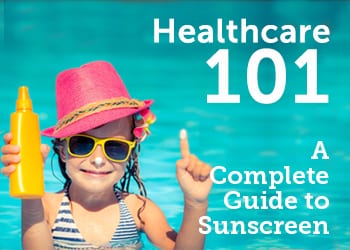Healthcare 101: A Complete Guide to Sunscreen
June 15, 2016

The sunny rays of summer feel great on your face, but UV light can seriously damage your skin and elevate your risk of skin cancer. Fortunately, you can still enjoy the outdoors while protecting yourself with sunscreen. Use this sunscreen guide to determine the type best for you!
Sunscreen and UV Rays
The purpose of sunscreen is to limit the amount of ultraviolet (UV) radiation that penetrates the skin. There are two major types of UV radiation that affect your health: UVA and UVB. These forms of ultraviolet radiation cause premature skin aging, damage to the skin and elevated risk of skin cancer. What’s the difference between these two types of UV radiation? UVA light penetrates the skin deeply and leads to sagging and wrinkling. UVB rays, on the other hand, are associated with sunburn.
It’s important to note that both types of ultraviolet light can increase your skin cancer risk, which makes it important to find a sunscreen that blocks them from penetrating the skin. When used properly, sunscreen forms a layer on the skin which protects it from ultraviolet light penetration.
What Is SPF?
The most important number on a bottle of sunscreen is the SPF, or sun protection factor. Many people misunderstand the meaning of this number. SPF refers to the ability of sunscreen to protect you against UVB rays. It is important to know that this scale is not linear. Thus, a SPF of 30 is not twice as effective as an SPF of 15. Info on various SPF levels:
- SPF 15 blocks 93% of ultraviolet rays
- SPF 30 blocks 97% of UV rays
- SPF 50 blocks 98% of UV rays
No sunscreen can block 100% of the ultraviolet light from the sun. Although higher SPF yields greater protection against UV light, the returns are incremental. Wearing an SPF 30 sunscreen is appropriate for most people, although you may want a higher SPF sunblock for your face.
How to Apply Sunscreen
The most common mistake people make when applying sunscreen is failing to apply enough. Putting on a very thin or inconsistent amount of sunscreen can leave your skin vulnerable to burning and the increased risk for skin cancer. To ensure you get the full benefit, apply 1 ounce of sunscreen to your body. Apply the sunscreen at least 30 minutes before you intend to go out into the sun to ensure that it binds to your skin to protect you.
Follow the directions on your sunscreen bottle to reapply. In general, it is best to reapply sunscreen every two hours. Make sure you apply more after swimming, toweling off or sweating profusely, as these activities can remove your protective layer of sunscreen. Certain formulations of sunscreen are labeled “sweat resistant” or “water resistant.” These tend to be slightly stickier, but they are a good choice when you are anticipating a hot or sweaty day. Also make sure that you wear sunscreen on cloudy days, as UV light easily penetrates the clouds. Wear your sunscreen and enjoy this beautiful summertime sun. If you do get burnt and need medical help, contact CareSpot. We treat burns, rashes and many other ailments.
